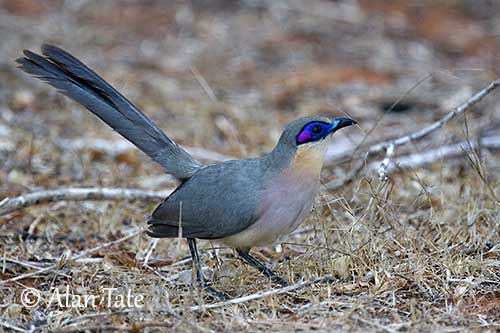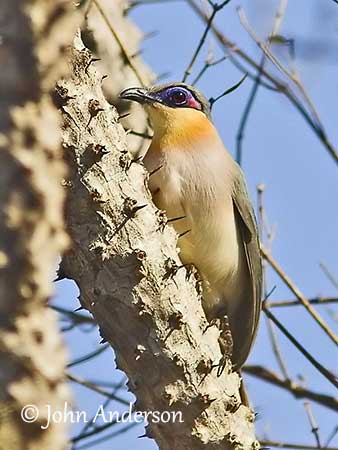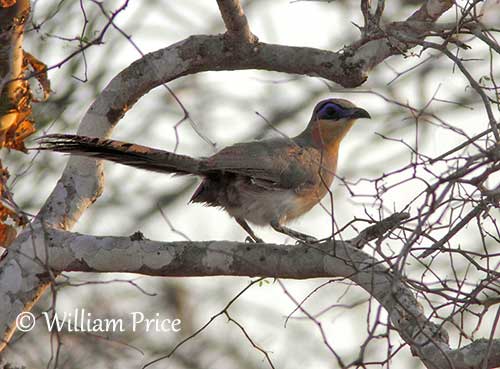
Fr: Coua coureur
Ang: Running Coua
All: Gelbkehl-Seidenkuckuck
Esp: Cúa Corredor
Ita: Cua corridore
Nd: Rencoua
Sd: löpkoua
Mal: Aliotse, Kadibake
Photographers:
John Anderson
John Anderson Photo Galleries
William Price
PBase-tereksandpiper & Flickr William Price
Alan & Ann Tate
AA Bird Photography
Text by Nicole Bouglouan
Sources:
HANDBOOK OF THE BIRDS OF THE WORLD vol 4 by Josep del Hoyo-Andrew Elliott-Jordi Sargatal - Lynx Edicions - ISBN: 8487334229
Cuckoos of the World Par Johannes Erritzøe, Clive F. Mann, Frederik Brammer, Richard A. Fuller – Editeurs A&C Black, 2012 – ISBN: 1408142678, 9781408142677
The Cuckoos Par Robert B. Payne – Editeur : OUP Oxford, 2005 – ISBN : 0191513555, 9780191513558
Birds of Madagascar: A Photographic Guide Par Pete Morris, Frank Hawkins – ISBN: 0300077556, 9780300077551- Editeur: Yale University Press, 1998
The Birds of Africa: Volume VIII: The Malagasy Region: Madagascar, Seychelles, Comoros, Mascarenes - Par Roger Safford, Frank Hawkins – ISBN: 1408190494, 9781408190494- Editeur: A&C Black, 2013
CREAGUS@Monterey Bay (Don Roberson)
Running Coua
Coua cursor
Cuculiformes Order – Cuculidae Family
INTRODUCTION:
The Running Coua is endemic to Madagascar where it frequents subtropical and tropical dry forests. It is found in SW and S coastal areas of the island. This large coua has strong feet indicating its terrestrial habits. It has the characteristic bright-coloured head pattern of the genus Coua. This species builds its own nest, and does not parasitize other bird species.
The Running Coua is uncommon within its restricted range, but it is not currently threatened.
DESCRIPTION OF THE BIRD:
Biometrics:
Length: 34-40 cm
Weight: 118 g
The Running Coua adult has pale grey-green upperparts with darker uppertail-coverts and long, graduated grey tail.
On the underparts, chin and throat are tawny-buff with paler centre. The breast is pale pinkish-brown and the belly is whitish. Flanks and undertail-coverts are grey. The undertail shows broad, white tips.
On the head, forehead, crown and nape are like the upperparts. We can see a black line around the face. The eye is surrounded by an oval patch of bare skin, blue around the eye and bright pink on the rear.
The bill is black. The eyes are deep red. The strong legs and feet are black.
Male and female are similar.

The juvenile is duller and the eye patch is mostly feathered. The feathers of back, rump, wing-coverts and also the flight-feathers are edged buff. There is not black on face. The eyes are dark brown and the bill is pale pinkish.
RANGE:
The Running Coua is found in SW and S coastal areas of Madagascar.
HABITAT:
The Running Coua frequents sub-arid, thorn scrub, spiny desert and dry woodland with limited undergrowth or grassy vegetation. It also occurs in sub-desert brush and on calcareous plateau with low forest bush. It does not frequent areas with only Euphorbia and gallery forest. It is visible from sea-level to 200 metres of elevation.
CALLS AND SONGS: SOUNDS BY XENO-CANTO
The Running Coua gives repeated, rapid series of 6-7 gruff whistles, with the 3-4 first notes high-pitched and the following notes shorter and quieter “gweerr-gweerr-gweerr gulk-gulk-gulk”. We can also hear a variation of this sound, a single whistle followed by several descending notes “weeer gulk-gulk-gul-gu”. From the ground, it gives a whistled “ay-reeyoo”.

BEHAVIOUR IN THE WILD:
The Running Coua feeds on spiders and various insects such as beetles of genus Curculionidae, cicadas and ants. It also consumes some plant materials.
As the name indicates, this species is terrestrial and feeds mainly on the ground. It may run swiftly to escape a danger or if threatened, but it usually walks and hops on the ground.
After a cold night, the Running Coua can be seen with erect rump feathers, exposing the black skin to the early morning sun. It is a secretive bird, often seen alone or in pairs.
The Running Coua is resident within its restricted range, but it is absent from parts of SW in January, February, May and August.
The flight is laboured and heavy.
REPRODUCTION OF THIS SPECIES:
The breeding season is closely related to the rains. The laying occurs in October and juveniles can be seen in February/March.
The Running Coua builds a bowl-shaped structure with twigs and bark, and the cup is lined with leaf stalks. It is placed in thick bush or in tree fork, about 2 metres above the ground.
The female lays two whitish eggs. The chicks are naked at hatching.
PROTECTION / THREATS / STATUS:
The Running Coua is probably trapped and hunted for food by local people. However, it is usually uncommon within its small range, but it is locally fairly common near Ifaty.
The species is not globally threatened and currently evaluated as Least Concern.
